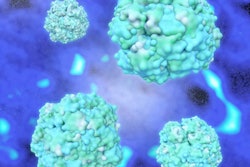
Hypofractionated, preoperative radiotherapy for patients with nonmetastatic soft tissue sarcoma (STS) can be delivered safely over three weeks and may become a "more convenient option" than conventional five-week treatment, researchers say.
 Dr. Ashleigh Guadagnolo.
Dr. Ashleigh Guadagnolo.The shortened regimen achieved similar tumor control with no increased risk of major wound complications compared with the standard of care -- five weeks of conventionally fractionated radiotherapy. The single-arm phase II study, led by Dr. Ashleigh Guadagnolo of the MD Anderson Cancer Center, was published in the Lancet Oncology on 4 November 2022.
"Our data indicate the three-week regimen offers patients a likely safe and effective alternative to the current standard of care with comparable outcomes in disease control and no increased risks of major wound complications," Guadagnolo said in a statement.
Guadagnolo said it was already known that patients receiving their treatment at cancer centers with sarcoma specialists had "better survival and functional outcomes."
"Being able to shorten our patients' treatment time from five to three weeks may improve care accessibility because patients would be able to reduce their time away from home if they do not live near a sarcoma specialty center," she said.
There has been a general shift towards the use of hypofractionation in the field of radiation oncology and interest has grown into whether an alternative dose fractionation schedule for the management of soft tissue sarcomas might obtain similar control rates to conventionally fractionated radiotherapy without increasing toxicity.
The single-center, open-label trial (HYPORT-STS) study investigated the safety of a moderately hypofractionated, shorter regimen of radiotherapy -- consisting of higher daily radiation therapy doses per treatment over fewer days relative to conventional therapy.
All 120 patients aged over 18 had nonmetastatic soft-tissue sarcoma in the extremity or superficial trunk; 65% of the participants had lower extremity tumors; 17% had upper extremity tumors; and 18% had tumors in the trunk.
The patients all received a three-week course of radiation consisting of 15 daily fractions of 2.85 Gray (Gy), totaling 42.75 Gy. (The current standard dose is 50 Gy in 25 daily fractions, or a five-week course).
Radiation therapy was followed by surgery four to eight weeks later. The researchers then assessed major wound complications within 120 days of surgery.
Major wound complications were defined as those requiring a secondary operation, or operations, under general or regional anesthesia for wound treatment; readmission to the hospital for wound care; invasive procedures for wound care; deep wound packing to an area of wound measuring at least 2 cm in length; prolonged dressing changes; repeat surgery for revision of a split-thickness skin graft; or wet dressings for longer than four weeks.
Analysis showed no patients experienced a serious adverse event or a grade 3 acute skin toxicity while in the study. Thirty-one percent of patients (37 out of 120 patients) developed major wound complications within 120 days of surgery. The historically observed rate is approximately 35% in patients treated with the standard five-week regimen.
Local tumor control in the trial was 93% at two-year follow-up, which is also comparable to historically reported rates with the longer treatment course. Guadagnolo noted that long-term side effects and oncologic and functional outcomes using the hypofractionated regimen are still being assessed.



















